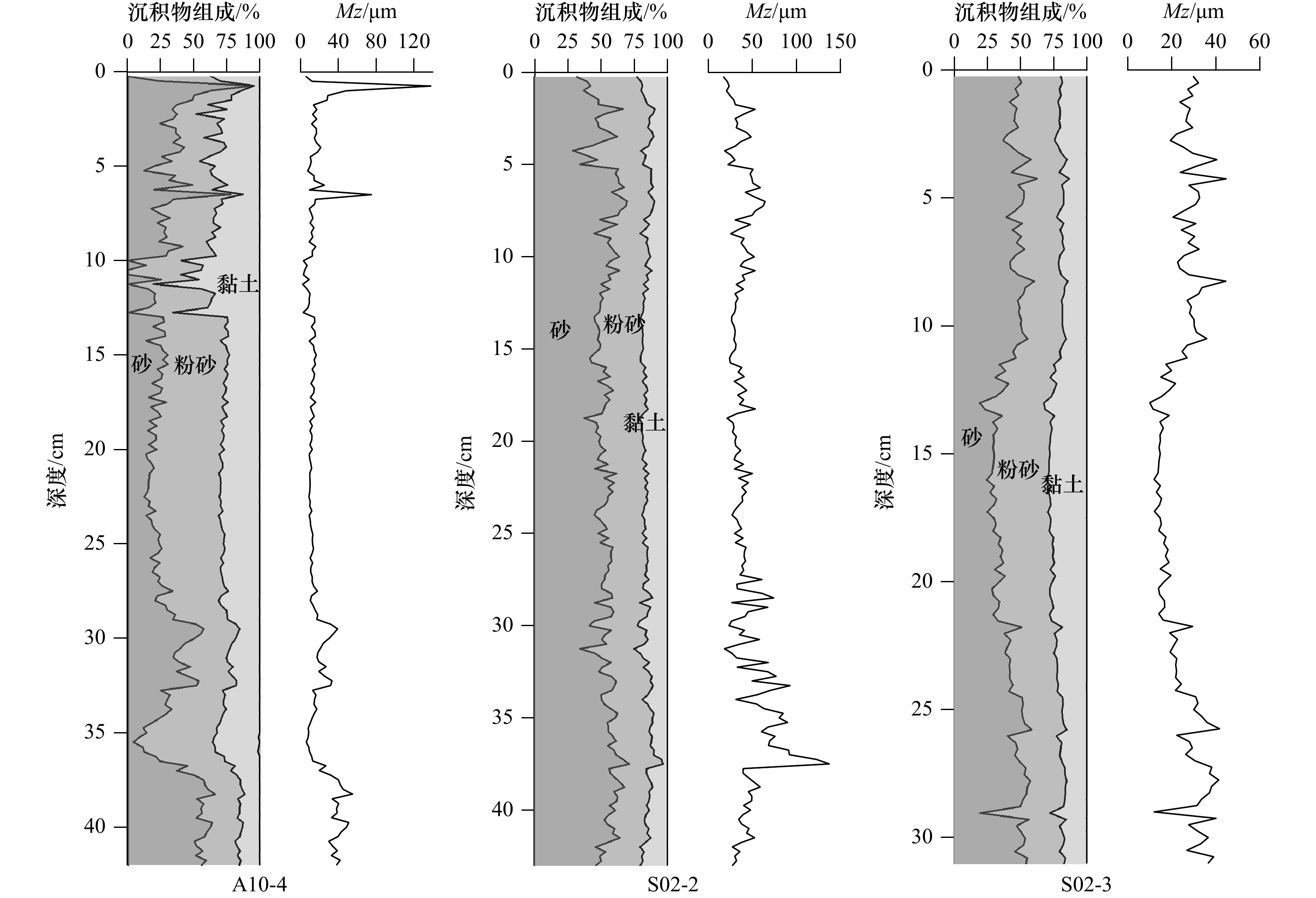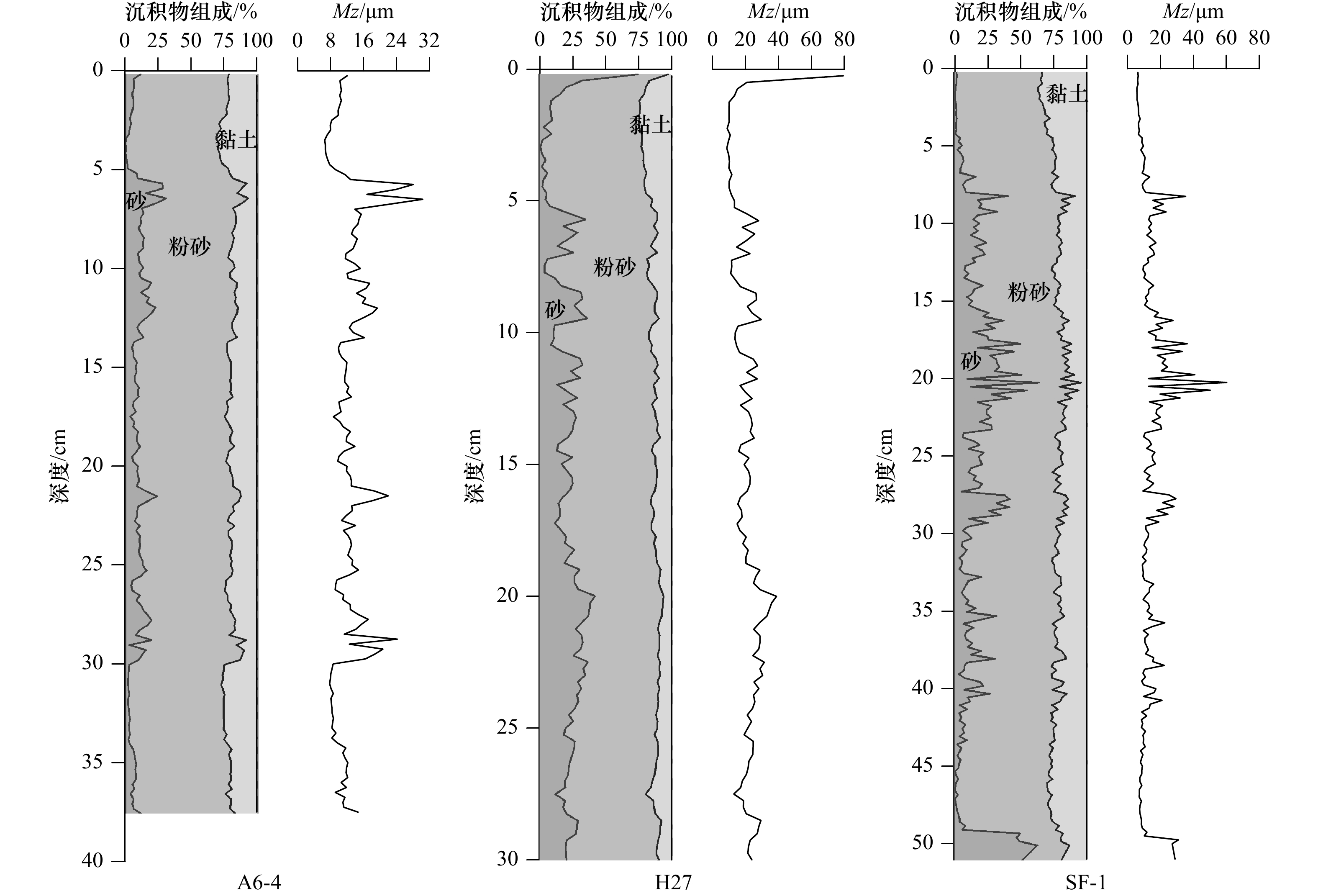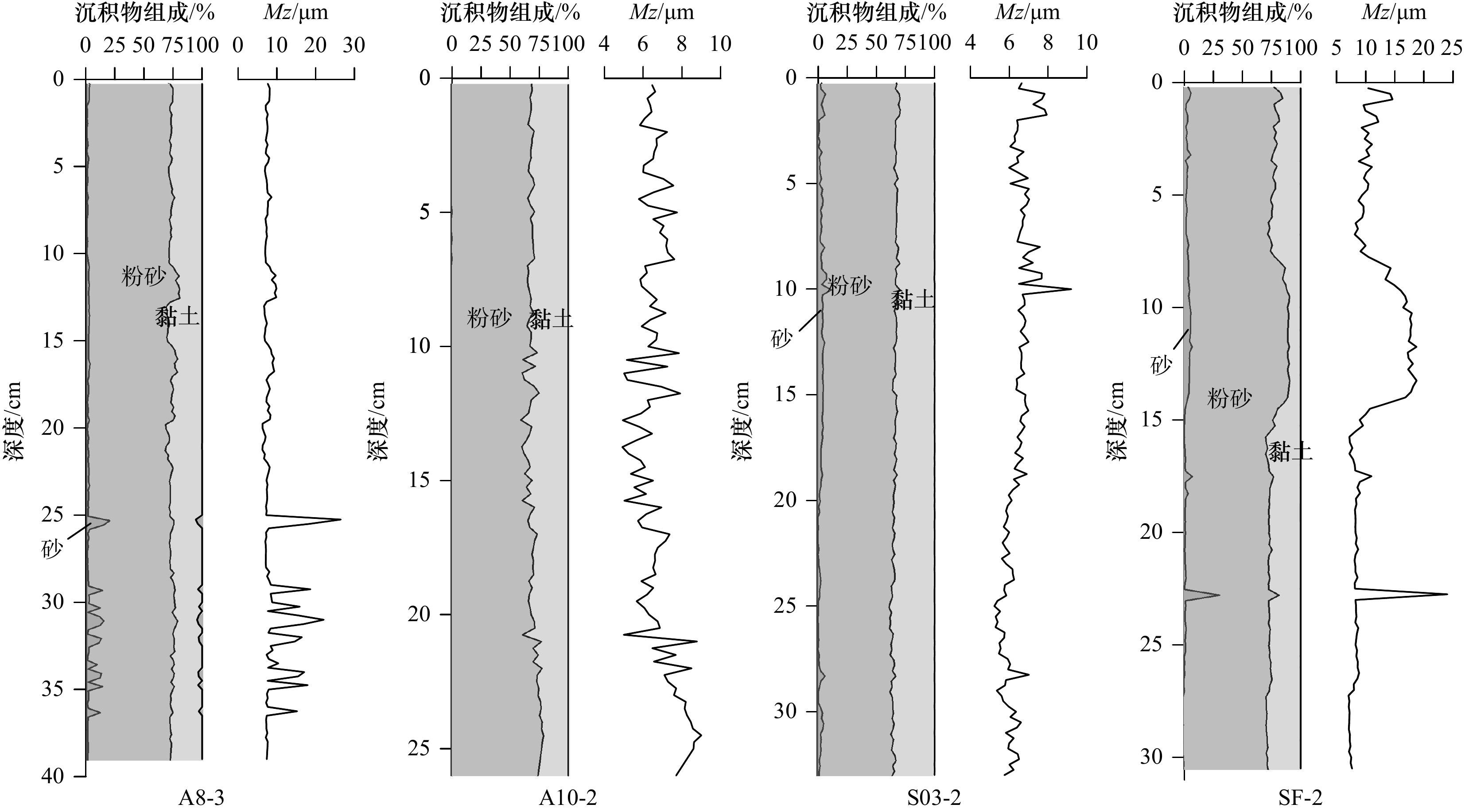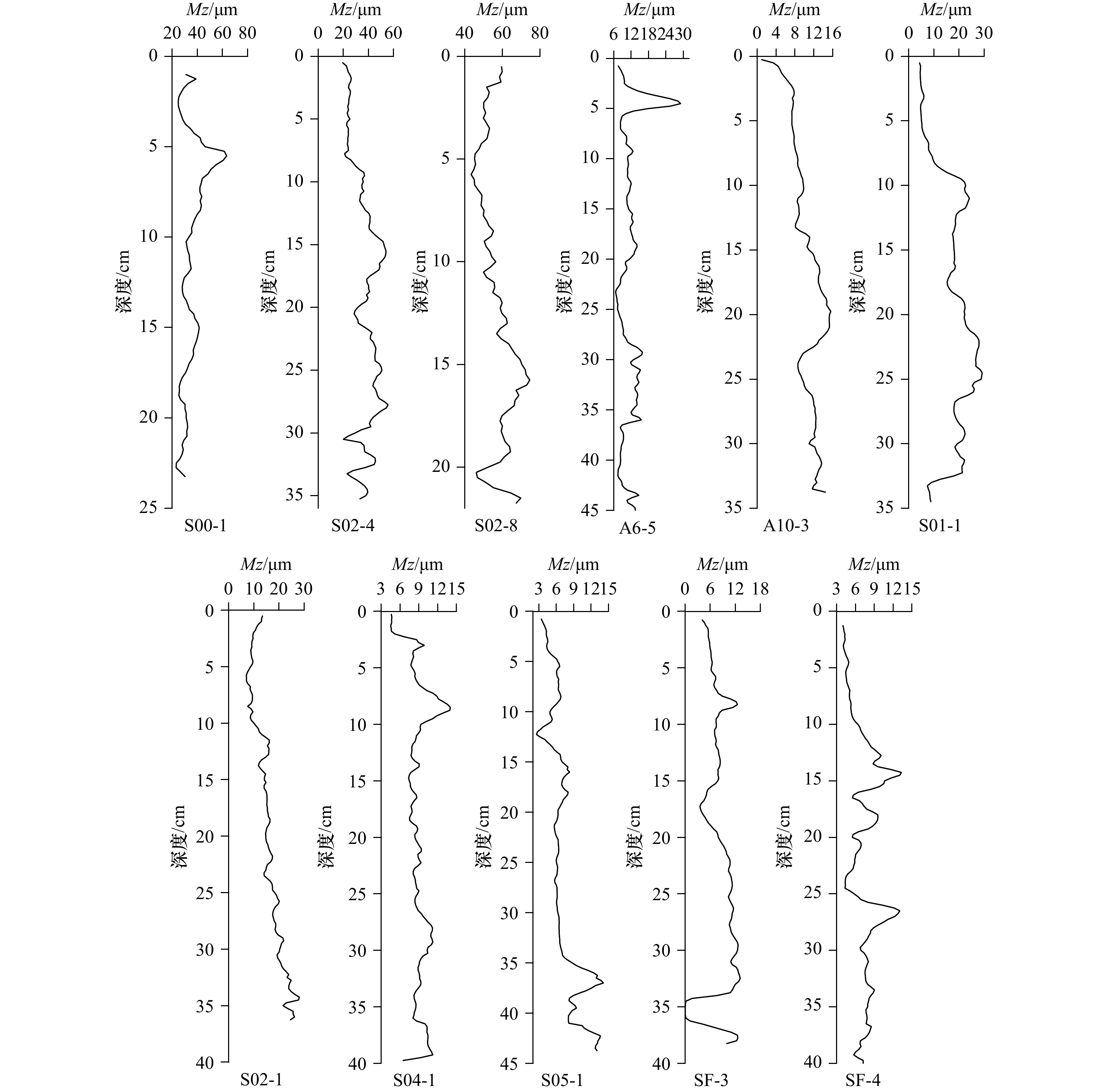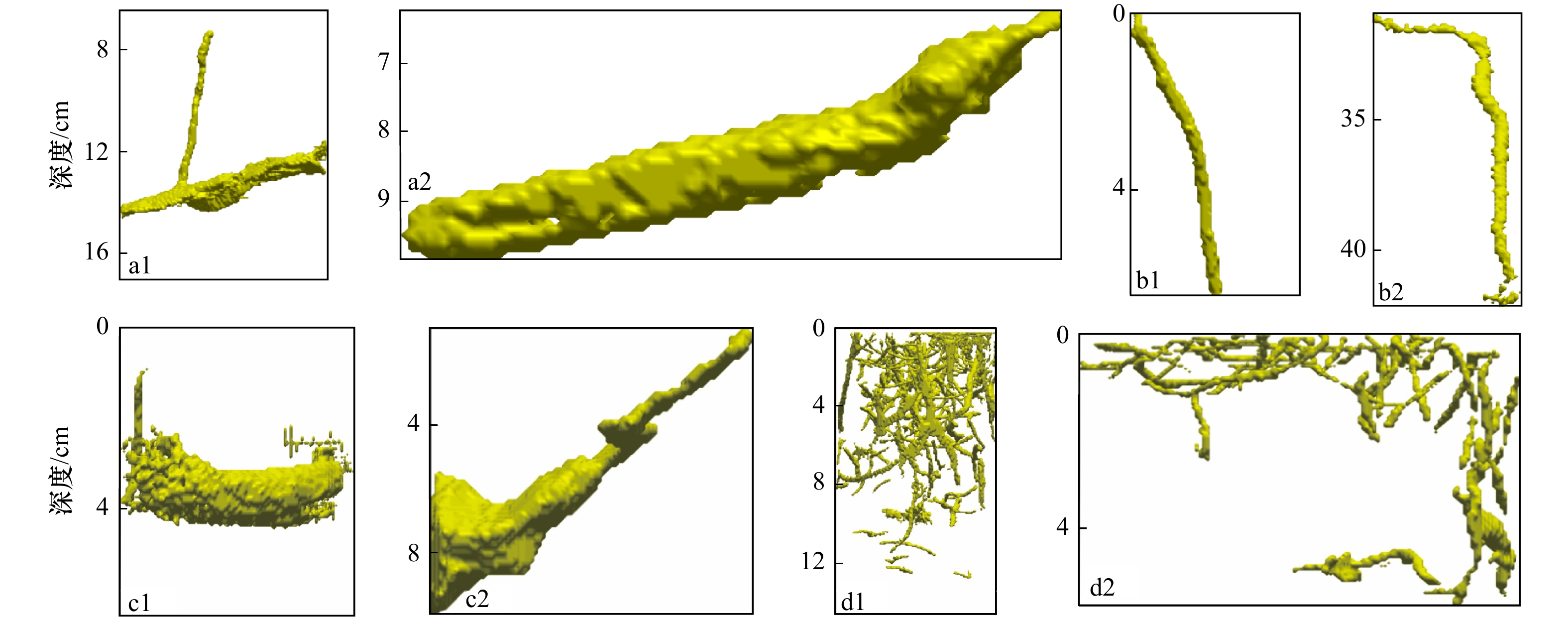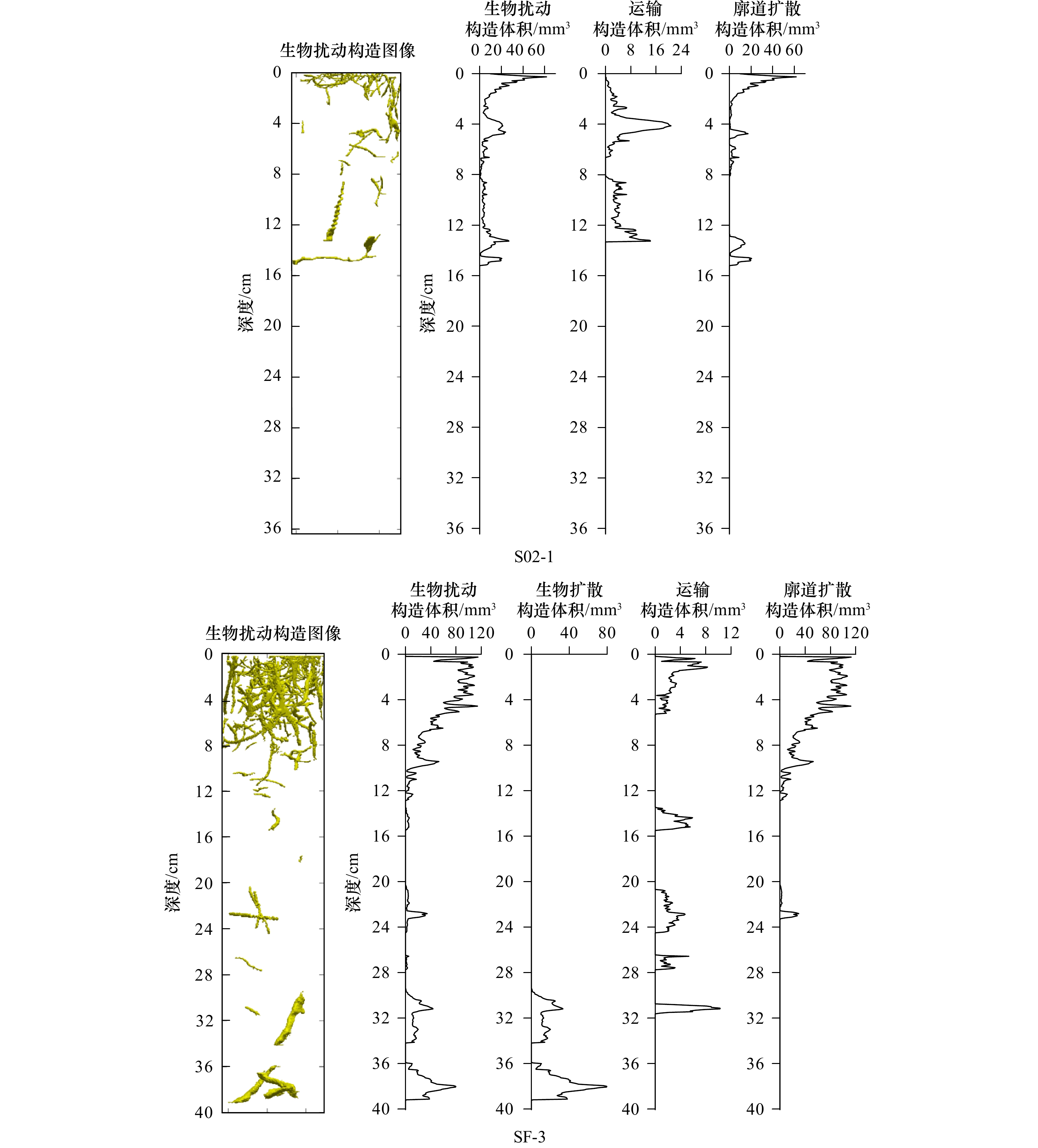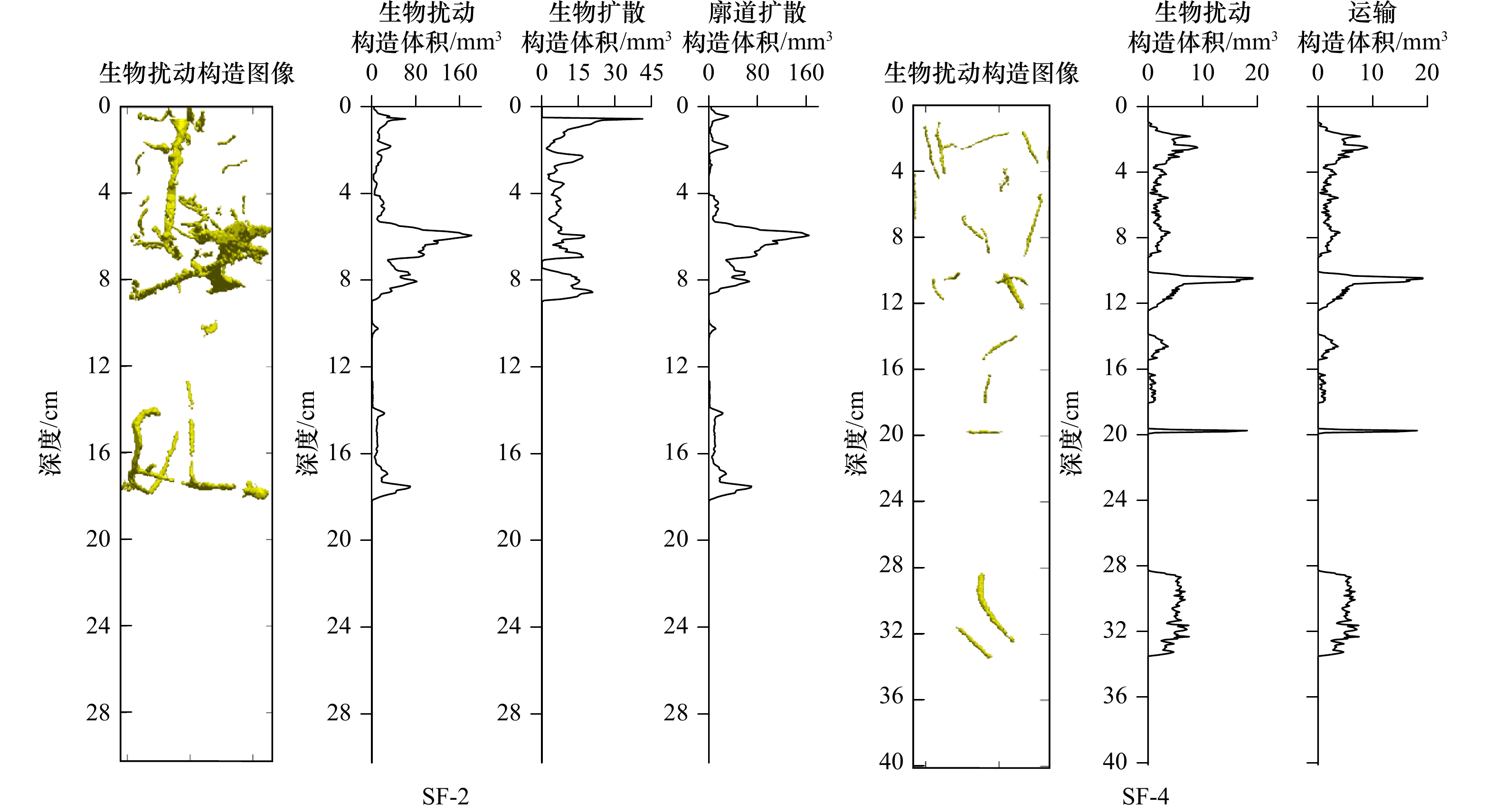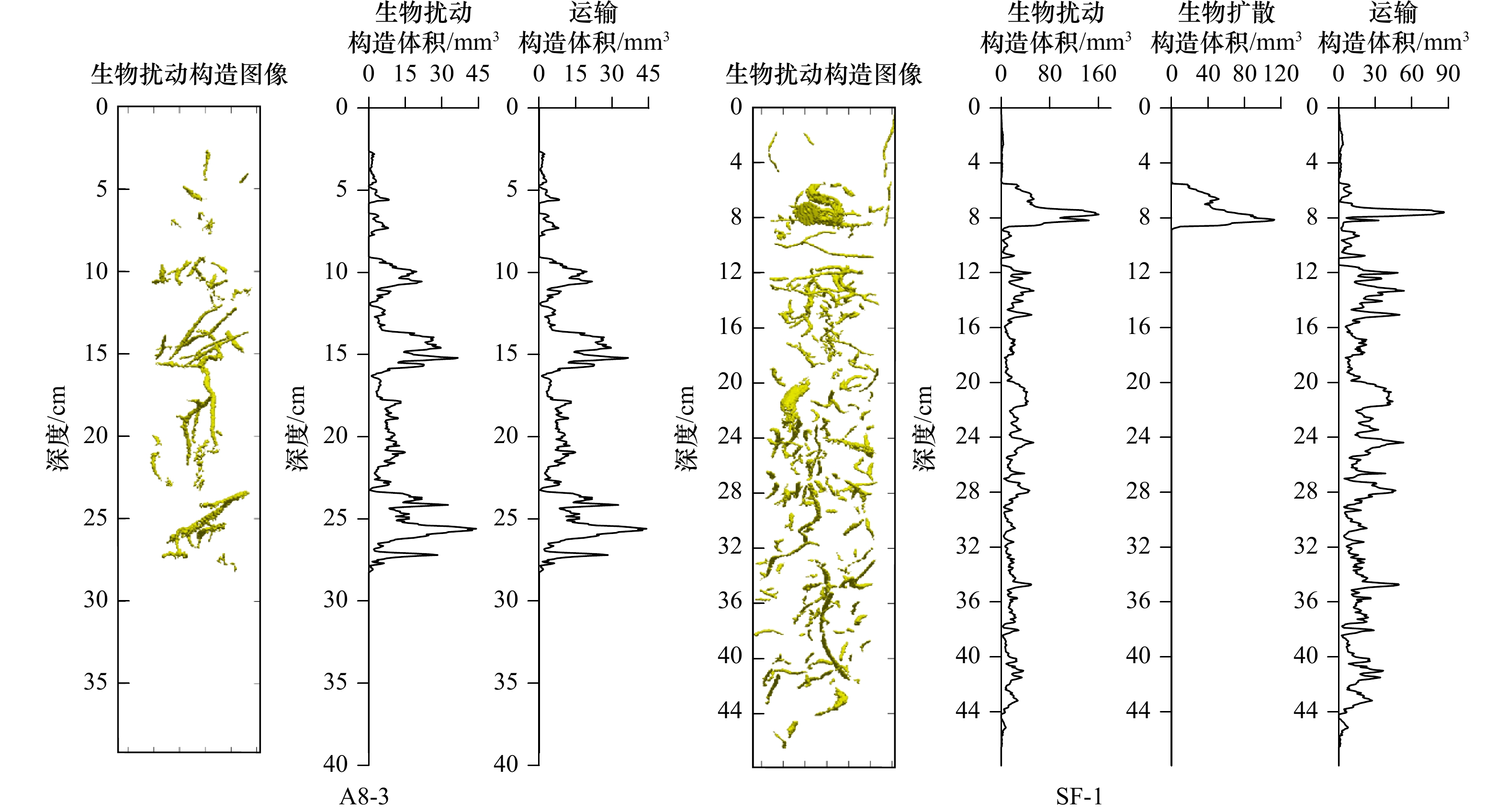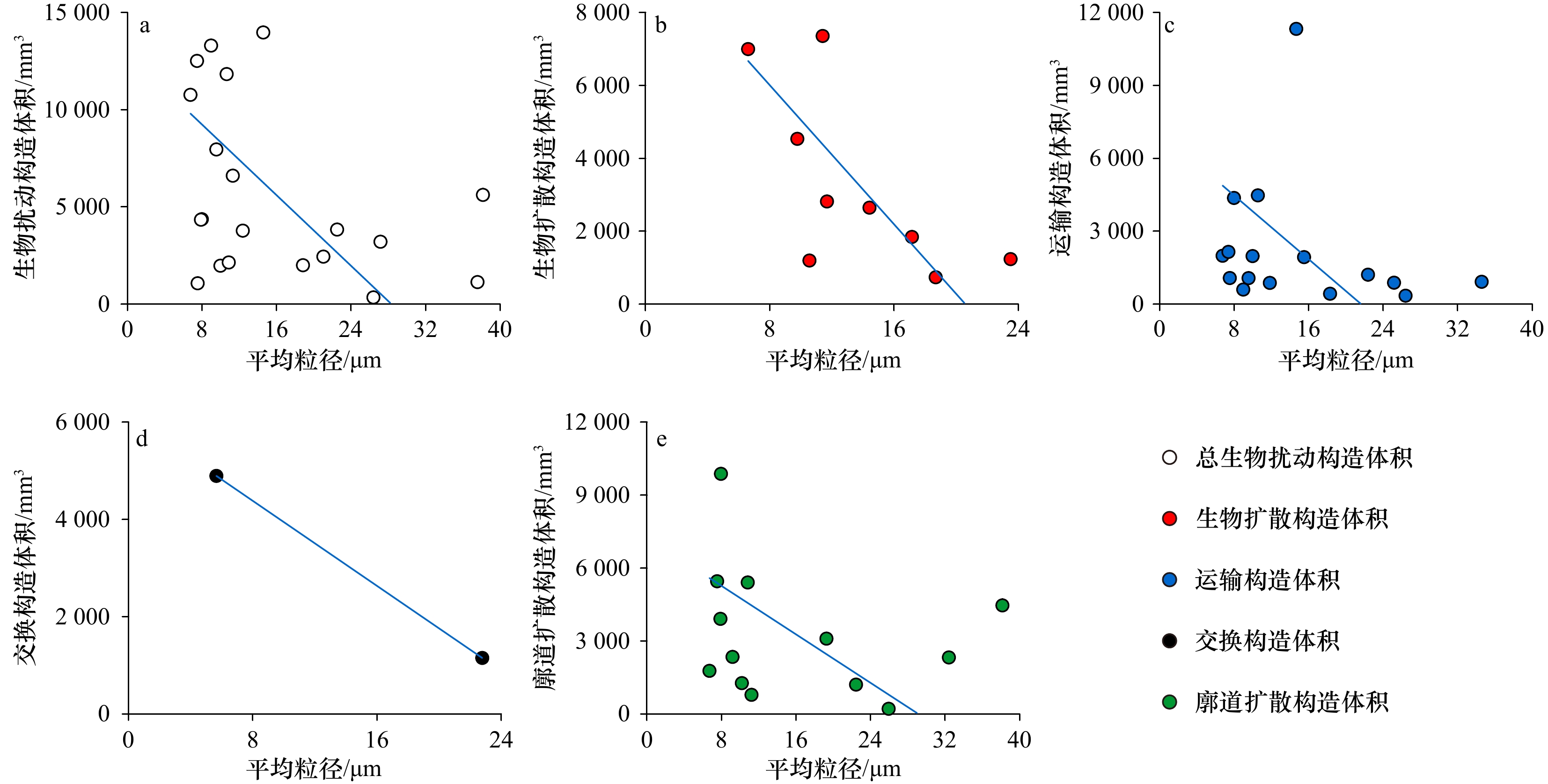Quantitative characterization and influencing factors of modern bioturbation structure in the Changjiang River Estuary and its adjacent areas
-
摘要: 生物扰动构造是表征海底环境状态的重要指标,是古沉积环境重建的主要依据,且它影响沉积物早期成岩作用以及物质的再分配,成为百年尺度沉积记录解读的干扰因素。本文基于长江口及其邻近海域的21个站位的沉积物岩心,利用高分辨X射线计算机断层扫描技术,通过matlab的数据处理,定性和定量表征了该区生物扰动构造,分析了影响生物扰动构造的主要因素。研究表明:长江口及邻近海域生物扰动构造较为发育,从功能上划分为生物扩散构造、运输构造、交换构造和廓道扩散构造4种类型,运输构造和廓道扩散构造常见;生物扰动构造在岩心中分布形式多样,包括指数衰减型、波动衰减型、均匀分布型、脉冲分布型等垂向分布形式;扰动深度深浅不一,多数在20 cm以内,但也有超过40 cm者;生物扰动构造空间上不均一,长江口及内陆架较发育,扰动构造体积在0~13 972 mm3之间,而苏北沿岸、中陆架则较少,扰动构造体积在351~3 212 mm3之间,从岸向外生物扰动构造有减少趋势。生物扰动构造发育程度主要受底质类型、沉积速率制约,黏土质粉砂以及适宜的沉积速率(0.52~1.34 cm/a)有利于生物扰动构造发育和保存。Abstract: The bioturbation structure is an important indicator of the state of the seabed environment and the main basis for the reconstruction of the paleosedimentary environment; moreover, it affects the early diagenesis of sediments and the redistribution of materials, and becomes the interference factor for the interpretation of the 100-year scale sedimentary records. In this article, sediment cores from 21 stations in the Changjiang River Estuary and its adjacent areas were characterized qualitatively and quantitatively by using high-resolution X-ray computed tomography technology, and the main factors affecting the bioturbation structures were analyzed. The result shows that the bioturbation structures in the Changjiang River Estuary and its adjacent areas are relatively developed, which can be divided into four types: biodiffusor structures, conveyor structures, regenerator structures and gallery-diffusor structures. Conveyor structures and gallery-diffusor structures are common. The bioturbation structure is distributed in various forms in the core, including exponential attenuation type, wave attenuation type, uniform distribution type, pulse distribution type and other vertical distribution forms. The depth of disturbance varies, most of which are within 20 cm, but some are more than 40 cm. The bioturbation structures are spatially uneven. The Changjiang River Estuary and the inner shelf are relatively developed, with a disturbance inventory of 0–13 972 mm3, while the northern Jiangsu coast and the middle continental shelf are less, with a disturbance inventory of 351–3 212 mm3. The bioturbation structures from the coast to the outside have a decreasing trend. The development degree of bioturbation structure is mainly restricted by the type of bottom material and sedimentation rate. Clay silt and suitable sedimentation rate (0.52–1.34 cm/a) are conducive to the development and preservation of bioturbation structures.
-
图 6 预测的沉积物岩心粒径特征
站位S00-1、S02-4、S02-8岩心沉积物平均粒径大于20 μm;站位A6-5、A10-3、S01-1、S02-1岩心沉积物平均粒径介于10~20 μm之间;站位S04-1、S05-1、SF-3、SF-4岩心沉积物平均粒径小于10 μm
Fig. 6 The predicted grain sizes of the sediment cores
The cores with mean grain sizes larger than 20 μm include S00-1, S02-4, and S02-8; the cores with mean grain sizes from 10 μm to 20 μm include A6-5, A10-3, S01-1, and S02-1; the cores with mean grain sizes less than 10 μm include S04-1, S05-1, SF-3, and SF-4
表 1 沉积物岩心站位信息
Tab. 1 Information for the sediment cores
站位 纬度 经度 科考船 岩心长度/cm 水深/m 取样时间 H27 32.40°N 122.30°E “蓝海101”号 30 25 2019年10月 A6-4 30.90°N 122.50°E “润江1”号 38 16.3 2019年7月 A6-5 30.80°N 122.60°E “润江1”号 46 20.8 2019年7月 A8-3 30.20°N 122.80°E “润江1”号 39 35.5 2019年7月 A10-2 29.70°N 122.60°E “润江1”号 26 30.1 2019年7月 A10-3 29.67°N 122.73°E “润江1”号 33.8 44.7 2019年7月 A10-4 29.60°N 122.80°E “润江1”号 42 48 2019年7月 S00-1 31.69°N 122.50°E “向阳红18”号 23.6 24.5 2020年10月 S01-1 29.99°N 122.69°E “向阳红18”号 3.6 37 2020年10月 S02-1 29.62°N 122.81°E “向阳红18”号 36.4 46.6 2020年10月 S02-2 29.47°N 123.09°E “向阳红18”号 43 58.1 2020年10月 S02-3 29.32°N 123.37°E “向阳红18”号 31 73.4 2020年10月 S02-4 29.17°N 123.65°E “向阳红18”号 35.4 75.3 2020年10月 S02-8 28.57°N 124.78°E “向阳红18”号 21.9 98.8 2020年10月 S03-2 28.47°N 122.58°E “向阳红18”号 33 71.3 2020年10月 S04-1 27.80°N 121.63°E “向阳红18”号 39.9 30.3 2020年10月 S05-1 27.00°N 120.93°E “向阳红18”号 44.8 41.9 2020年10月 SF-1 31.17°N 122.56°E “向阳红18”号 49 24.6 2020年10月 SF-2 30.49°N 122.67°E “向阳红18”号 31 35 2020年10月 SF-3 29.17°N 122.57°E “向阳红18”号 40.1 44.4 2020年10月 SF-4 27.41°N 121.32°E “向阳红18”号 40.1 41.4 2020年10月 表 2 各类型生物扰动构造特征
Tab. 2 Characteristics of various types of bioturbation structures
生物扰动 最大长度/cm 最大直径/cm 形态 分布粒径/μm 分布深度/cm 生物扩散构造 10.00 1.75 长柱状、短柱状 9.10~18.70 0~13.00 运输构造 10.00 1.00 I型、螺旋型 7.40~25.80 0~43.50 交换构造 5.70 1.52 短柱状、U型 5.70~22.80 0~4.50 廓道扩散构造 17.50 1.25 根系状、Y型、8字型 7.30~39.50 0~18.80 -
[1] 王慧中. 江浙一带现代海滩的生物扰动构造及其指相意义[J]. 地质科学, 1985, 20(1): 53−58.Wang Huizhong. Bioturbation structures of modern beach sediments and their significance in determining of sedimentary environments in Jiangsu and Zhejiang provinces[J]. Chinese Journal of Geology, 1985, 20(1): 53−58. [2] Cutter Jr G R, Diaz R J. Biological alteration of physically structured flood deposits on the Eel margin, northern California[J]. Continental Shelf Research, 2000, 20(3): 235−253. doi: 10.1016/S0278-4343(99)00059-X [3] Kniskern T A, Kuehl S A. Spatial and temporal variability of seabed disturbance in the York River subestuary[J]. Estuarine, Coastal and Shelf Science, 2003, 58(1): 37−55. doi: 10.1016/S0272-7714(03)00052-0 [4] 范德江, 徐琳, 齐红艳. 长江水下三角洲浅表沉积层中的生物扰动构造[J]. 海洋与湖沼, 2008, 39(6): 577−584. doi: 10.3321/j.issn:0029-814X.2008.06.006Fan Dejiang, Xu Lin, Qi Hongyan. Bioturbation in surficial sediments of subaqueous Changjiang (Yangtze) River Delta[J]. Oceanologia et Limnologia Sinica, 2008, 39(6): 577−584. doi: 10.3321/j.issn:0029-814X.2008.06.006 [5] 覃雪波, 孙红文, 彭士涛, 等. 生物扰动对沉积物中污染物环境行为的影响研究进展[J]. 生态学报, 2014, 34(1): 59−69.Qin Xuebo, Sun Hongwen, Peng Shitao, et al. Review of the impacts of bioturbation on the environmental behavior of contaminant in sediment[J]. Acta Ecologica Sinica, 2014, 34(1): 59−69. [6] He Yi, Men Bin, Yang Xiaofang, et al. Investigation of heavy metals release from sediment with bioturbation/bioirrigation[J]. Chemosphere, 2017, 184: 235−243. doi: 10.1016/j.chemosphere.2017.05.177 [7] 田家庆. 颤蚓扰动对沉积物中Cu和Zn生物富集的影响[D]. 长春: 吉林大学, 2020.Tian Jiaqing. Effects of tubificid bioturbation on bioaccumulation of Cu and Zn released from sentiment by aquatic organisms[D]. Changchun: Jilin University, 2020. [8] Casado-Coy N, Sánchez-Jerez P, Holmer M, et al. Bioturbation may not always enhance the metabolic capacity of organic polluted sediments[J]. Marine Environmental Research, 2020, 155: 104882. doi: 10.1016/j.marenvres.2020.104882 [9] Nie Likai, Li Yue, Hou Yongchao, et al. Dynamics of organic carbon under bioturbation by mud crabs ( Macrophthalmus japonicus) and clamworms ( Perinereis aibuhitensis) in an estuary ecosystem[J]. Journal of Experimental Marine Biology and Ecology, 2021, 534: 151474. doi: 10.1016/j.jembe.2020.151474 [10] 杨群慧, 周怀阳, 季福武, 等. 海底生物扰动作用及其对沉积过程和记录的影响[J]. 地球科学进展, 2008, 23(9): 932−941. doi: 10.3321/j.issn:1001-8166.2008.09.004Yang Qunhui, Zhou Huaiyang, Ji Fuwu, et al. Bioturbation in seabed sediments and its effects on marine sedimentary processes and records[J]. Advances in Earth Science, 2008, 23(9): 932−941. doi: 10.3321/j.issn:1001-8166.2008.09.004 [11] 康兴伦. 210Pb测年法的数据处理问题[J]. 海洋科学, 1986, 10(6): 13−17.Kang Xinglun. On the data treatment of 210Pb dating method[J]. Marine Sciences, 1986, 10(6): 13−17. [12] 范德江, 杨作升, 郭志刚. 中国陆架210Pb测年应用现状与思考[J]. 地球科学进展, 2000, 15(3): 297−302.Fan Dejiang, Yang Zuosheng, Guo Zhigang. Review of 210Pb dating in the continental shelf of China[J]. Advances in Earth Science, 2000, 15(3): 297−302. [13] Lewis R C, Coale K H, Edwards B D, et al. Accumulation rate and mixing of shelf sediments in the Monterey Bay National Marine Sanctuary[J]. Marine Geology, 2002, 181(1/3): 157−169. [14] Teal L R, Bulling M T, Parker E R, et al. Global patterns of bioturbation intensity and mixed depth of marine soft sediments[J]. Aquatic Biology, 2008, 2(3): 207−218. doi: 10.3354/ab00052 [15] Pennafirme S, Machado A S, Machado A C, et al. Monitoring bioturbation by a small marine polychaete using microcomputed tomography[J]. Micron, 2019, 121: 77−83. doi: 10.1016/j.micron.2019.03.004 [16] 米智, 范德江, 刘晓航, 等. 基于计算机断层扫描技术重构三维生物扰动构造——以长江口现代沉积为例[J]. 海洋与湖沼, 2021, 52(6): 1388−1398.Mi Zhi, Fan Dejiang, Liu Xiaohang, et al. Three-dimensional reconstruction of bioturbation structure of modern sediments in Changjiang River Estuary using computer tomography[J]. Oceanologia et Limnologia Sinica, 2021, 52(6): 1388−1398. [17] 刘录三, 郑丙辉, 李宝泉, 等. 长江口大型底栖动物群落的演变过程及原因探讨[J]. 海洋学报, 2012, 34(3): 134−145.Liu Lusan, Zheng Binghui, Li Baoquan, et al. Long-term trends of macrobenthos in Changjiang Estuary, China in relation to environmental changes[J]. Haiyang Xuebao, 2012, 34(3): 134−145. [18] 胡颢琰, 唐静亮, 李秋里, 等. 浙江省近岸海域底栖生物生态研究[J]. 海洋学研究, 2006, 24(3): 76−89. doi: 10.3969/j.issn.1001-909X.2006.03.008Hu Haoyan, Tang Jingliang, Li Qiuli, et al. Studies on benthic ecology in Zhejiang coastal waters[J]. Journal of Marine Sciences, 2006, 24(3): 76−89. doi: 10.3969/j.issn.1001-909X.2006.03.008 [19] 沈辉. 富营养化沉积物生物修复及生物扰动对微生物群落结构的影响[D]. 上海: 上海海洋大学, 2016.Shen Hui. Bioremediation of eutrophic sediment and response of microbial communities to bioturbation by benthic macrofauna[D]. Shanghai: Shanghai Ocean University, 2016. [20] 陈中原, 周长振, 杨文达, 等. 长江口外现代水下地貌与沉积[J]. 东海海洋, 1986, 4(2): 29−37.Chen Zhongyuan, Zhou Changzhen, Yang Wenda, et al. Subaqueous topography and sediments off modern Changjiang Estuary[J]. Donghai Marine Science, 1986, 4(2): 29−37. [21] 刘胜璟, 高建华, 徐笑梅, 等. 浙闽沿岸泥质区沉积物粒度组分对长江入海输沙量减少的响应[J]. 海洋学报, 2021, 43(3): 105−115.Liu Shengjing, Gao Jianhua, Xu Xiaomei, et al. Response of sediment grain size composition of the Zhe-Min coastal mud to the sediment load reduction of the Changjiang River entering the sea[J]. Haiyang Xuebao, 2021, 43(3): 105−115. [22] 喻薛凝, 战庆, 王张华. 长江口各地貌单元沉积构造和粒度分区特征[J]. 海洋地质与第四纪地质, 2016, 36(4): 1−11. doi: 10.16562/j.cnki.0256-1492.2016.04.001Yu Xuening, Zhan Qing, Wang Zhanghua. Sedimentary structures and grain size patterns of the geomorphic units in the Yangtze River Mouth[J]. Marine Geology & Quaternary Geology, 2016, 36(4): 1−11. doi: 10.16562/j.cnki.0256-1492.2016.04.001 [23] 陈中原, 许世远, 严钦尚. 全新世长江水下三角洲沉积相的研究[J]. 海洋与湖沼, 1991, 22(1): 29−37.Chen Zhongyuan, Xu Shiyuan, Yan Qinshang. Sedimentary facies of Holocene subaqueous Changjiang River Delta[J]. Oceanologia et Limnologia Sinica, 1991, 22(1): 29−37. [24] 秦蕴珊. 东海地质[M]. 北京: 科学出版社, 1987.Qin Yunshan. Geology of the East China Sea[M]. Beijing: Science Press, 1987. [25] 石学法, 刘升发, 乔淑卿, 等. 东海闽浙沿岸泥质区沉积特征与古环境记录[J]. 海洋地质与第四纪地质, 2010, 30(4): 19−30.Shi Xuefa, Liu Shengfa, Qiao Shuqing, et al. Depositional features and Palaeoenvironmental records of the mud deposits in Min-Zhe coastal mud area, East China Sea[J]. Marine Geology & Quaternary Geology, 2010, 30(4): 19−30. [26] Yang Zuosheng, Wang Houjie, Saito Y, et al. Dam impacts on the Changjiang (Yangtze) River sediment discharge to the sea: the past 55 years and after the Three Gorges Dam[J]. Water Resources Research, 2006, 42(4): W04407. [27] 苏纪兰. 中国近海的环流动力机制研究[J]. 海洋学报, 2001, 23(4): 1−16.Su Jilan. A review of circulation dynamics of the coastal oceans near China[J]. Haiyang Xuebao, 2001, 23(4): 1−16. [28] Liu J P, Li Anchun, Xu Kehui, et al. Sedimentary features of the Yangtze River-derived along-shelf clinoform deposit in the East China Sea[J]. Continental Shelf Research, 2006, 26(17/18): 2141−2156. [29] 王延明, 李道季, 方涛, 等. 长江口及邻近海域底栖生物分布及与低氧区的关系研究[J]. 海洋环境科学, 2008, 27(2): 139−143, 164. doi: 10.3969/j.issn.1007-6336.2008.02.010Wang Yanming, Li Daoji, Fang Tao, et al. Study on relation of distribution of benthos and hypoxia in Yangtze River Estuary and adjacent sea[J]. Marine Environmental Science, 2008, 27(2): 139−143, 164. doi: 10.3969/j.issn.1007-6336.2008.02.010 [30] 孙亚伟, 曹恋, 秦玉涛, 等. 长江口邻近海域大型底栖生物群落结构分析[J]. 海洋通报, 2007, 26(2): 66−70. doi: 10.3969/j.issn.1001-6392.2007.02.010Sun Yawei, Cao Lian, Qin Yutao, et al. Analysis of macrobenthos community structure in the adjacent sea area of Changjiang River Eastuary[J]. Marine Science Bulletin, 2007, 26(2): 66−70. doi: 10.3969/j.issn.1001-6392.2007.02.010 [31] Qiao Shuqing, Shi Xuefa, Wang Guoqing, et al. Sediment accumulation and budget in the Bohai sea, Yellow Sea and East China sea[J]. Marine Geology, 2017, 390: 270−281. doi: 10.1016/j.margeo.2017.06.004 [32] Hainsworth J M, Aylmore L A G. The use of computer assisted tomography to determine spatial distribution of soil water content[J]. Australian Journal of Soil Research, 1983, 21(4): 435−443. doi: 10.1071/SR9830435 [33] Rogasik H, Onasch I, Brunotte J, et al. Assessment of soil structure using X-ray computed tomography[J]. Geological Society, London, Special Publications, 2003, 215(1): 151−165. doi: 10.1144/GSL.SP.2003.215.01.14 [34] Fisher J B, Lick W J, McCall P L, et al. Vertical mixing of lake sediments by tubificid oligochaetes[J]. Journal of Geophysical Research:Oceans, 1980, 85(C7): 3997−4006. doi: 10.1029/JC085iC07p03997 [35] Boudreau B P. Mathematics of tracer mixing in sediments; II, Nonlocal mixing and biological conveyor-belt phenomena[J]. American Journal of Science, 1986, 286(3): 199−238. doi: 10.2475/ajs.286.3.199 [36] Smith J N, Boudreau B P, Noshkin V. Plutonium and 210Pb distributions in northeast Atlantic sediments: subsurface anomalies caused by non-local mixing[J]. Earth and Planetary Science Letters, 1986, 81(1): 15−28. doi: 10.1016/0012-821X(86)90097-X [37] Gardner L R, Sharma P, Moore W S. A regeneration model for the effect of bioturbation by fiddler crabs on 210Pb profiles in salt marsh sediments[J]. Journal of Environmental Radioactivity, 1987, 5(1): 25−36. doi: 10.1016/0265-931X(87)90042-7 [38] Gérino M, Stora G, François-Carcaillet F, et al. Macro-invertebrate functional groups in freshwater and marine sediments: a common mechanistic classification[J]. Life & Environment, 2003, 53(4): 221−231. [39] Kristensen E, Kostka J E. Macrofaunal burrows and irrigation in marine sediment: microbiological and biogeochemical interactions[C]//Interactions Between Macro- and Microorganisms in Marine Sediments. Washington: American Geophysical Union, 2005, 60: 125−157. [40] Dashtgard S E, Gingras M K, Pemberton S G. Grain-size controls on the occurrence of bioturbation[J]. Palaeogeography, Palaeoclimatology, Palaeoecology, 2008, 257(1/2): 224−243. [41] 刘道彬. 底栖动物对黄河口海床土渗透性影响的试验研究[D]. 青岛: 中国海洋大学, 2008.Liu Daobin. Experimentation research of sediment permeability induced by the bioturbation in the Yellow River Estuary[D]. Qingdao: Ocean University of China, 2008. [42] Tromp T K, Van Cappellen P, Key R M. A global model for the early diagenesis of organic carbon and organic phosphorus in marine sediments[J]. Geochimica et Cosmochimica Acta, 1995, 59(7): 1259−1284. doi: 10.1016/0016-7037(95)00042-X [43] 覃雪波. 生物扰动对河口沉积物中多环芳烃环境行为的影响[D]. 天津: 南开大学, 2010.Qin Xuebo. Impacts of bioturbance on the environmental behavior of polycyclic aromatic hydrocarbons in estuarine sediment[D]. Tianjin: Nankai University, 2010. [44] Rhoads D C, Boyer L F. The effects of marine benthos on physical properties of sediments: a successional perspective[M]//McCall P L, Tevesz M J S. Animal-Sediment Relations. Boston: Springer, 1982. [45] 刘录三, 李新正. 东海春秋季大型底栖动物分布现状[J]. 生物多样性, 2002, 10(4): 351−358. doi: 10.17520/biods.2002049Liu Lusan, Li Xinzheng. Distribution of macrobenthos in spring and autumn in the East China Sea[J]. Biodiversity Science, 2002, 10(4): 351−358. doi: 10.17520/biods.2002049 [46] 郭志刚, 杨作升, 张东奇, 等. 冬、夏季东海北部悬浮体分布及海流对悬浮体输运的阻隔作用[J]. 海洋学报, 2002, 24(5): 71−80.Guo Zhigang, Yang Zuosheng, Zhang Dongqi, et al. Seasonal distribution of suspended matter in the northern East China Sea and barrier effect of current circulation on its transport[J]. Haiyang Xuebao, 2002, 24(5): 71−80. [47] 曹公平. 长江口邻近海域夏季上升流演变机制研究[D]. 青岛: 中国科学院海洋研究所, 2012.Cao Gongping. Mechanism study of upwelling evolvement in the Yangtze River Estuary adjacent waters in summer[D]. Qingdao: Institute of Oceanology, Chinese Academy of Sciences, 2012. [48] Bhattacharya J P, Howell C D, MacEachern J A, et al. Bioturbation, sedimentation rates, and preservation of flood events in deltas[J]. Palaeogeography, Palaeoclimatology, Palaeoecology, 2020, 560: 110049. doi: 10.1016/j.palaeo.2020.110049 [49] Gingras M K, MacEachern J A, Dashtgard S E, et al. Chapter 16-Estuaries[J]. Developments in Sedimentology, 2012, 64: 463−505. -





 下载:
下载:

